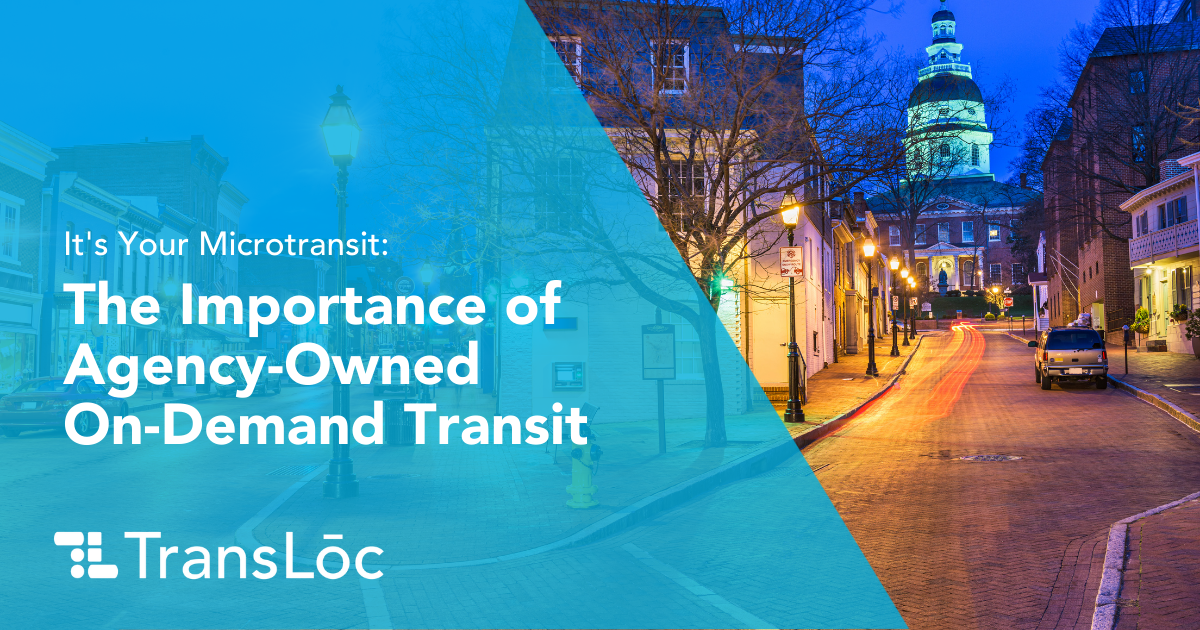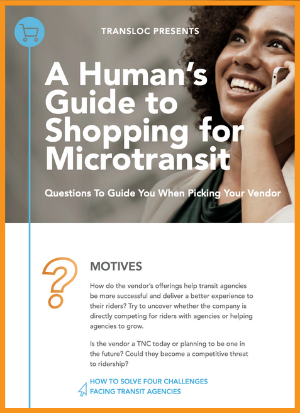
In the past, transit systems were built to provide an efficient, balanced supply of transportation that met the needs of the mass population.
Today, private transportation network companies (TNCs) offer flexible on-demand microtransit mobility options to communities. Local transit agencies are now competing to attract and retain riders by implementing flexible, demand-response services to complement traditional fixed-route services — all in an effort to deliver an exceptional and equitable rider experience.
The question is, who should own these transformative services?
Put Community Experts in Control
City and transit leaders are most equipped with the expertise and historical knowledge on how their communities will respond to a new mobility service. After all, they regularly listen to the unique needs of their constituents and riders, evaluate current service gaps, and work diligently to improve wait times without sacrificing safety. By taking control of on-demand microtransit, agencies can scale their workforce to meet service growth, reallocate resources to support emerging rider trends, and collaborate with other public or private agencies to rethink community services.
Equitable, Affordable, and Sustainable Transportation Become Top Priorities
Transit agencies are mandated — through government requirements such as Title VI and ADA compliance — to offer nondiscriminatory transportation that enhances the social and economic quality of life for its citizens. When it comes to personal mobility, no other group shares this same public duty.

City and transit leaders should be at the heart of making decisions around the equity, affordability, and sustainability of their transportation services. Agency-owned on-demand microtransit can be tactful responses to vehicle and parking congestion, proof of compliance for vehicle-miles-traveled mandates, or neighborhoods in need of curb-to-curb paratransit.
Transit agencies possess the non-profit status to properly invest, test, and deliver successful on-demand microtransit. Many agencies are being approached by TNCs for funding and cooperation. There is no question that TNCs play an important part in the future of mobility. However, in situations where cities and agencies subsidize TNCs to provide a turnkey service, pricing can be more than the standard public transit fare, making these services generally inaccessible to under-resourced communities. In addition, while TNCs are working to address service equity, they cannot guarantee that their drivers will provide equal coverage around town.
The agency-owned model addresses these inequities by controlling service distribution and properly hiring and training drivers. Many transit agencies also take an adaptive approach to ensure their on-demand microtransit service reaches all of their riders. For example, dispatchers who can book on-demand reservations over the phone improve accessibility for riders who do not own a mobile device or computer.
Data Transparency Drives Agile Innovation
TNCs often share limited data with agency partners whereas the data produced by on-demand microtransit is 100% accessible to the agency and the city. By having full access to this data, transit agencies can identify mobility patterns that can be used to shape on-demand and fixed-route services alike. Data from a 2017 study at The University of California, Davis indicates that:
When you aggregate the behavior of many people, transportation becomes less efficient when transit riders switch to cars, when new car services entice people onto trips they wouldn’t otherwise have taken, or when people who give up their cars wind up traveling even more in someone else’s.
It’s equally not preordained that these apps will make traffic worse, or that they must come at the expense of public transit. If more people left their solo cars for car-pooled ride-hailing, rather than leaving public buses for solo [TNC] rides, that would reduce the number of cars on the road and the miles they travel. If transit agencies partnered with these companies, ride-hailing could fill niches that trains and buses don’t handle well, like late-night journeys, transit for riders with disabilities, and suburban service.
By being agency-owned, data can be used to pilot — and then quickly and efficiently expand — new services. You can launch rapidly and gain rich data along the way. Plus, the data is on hand to help prove the case for new funding. Launching a new on-demand microtransit service doesn’t have to be a solo venture. While maintaining ownership is critical, you also need the right partners who can complement the expertise of your team. Our approach to partnerships at TransLoc is to serve as an extension of your staff; not a replacement. Working together, we can optimize your transit system to bring flexible and dependable mobility solutions to your community.